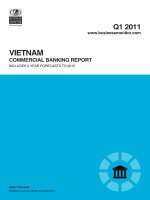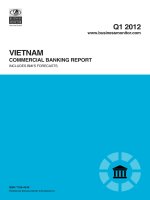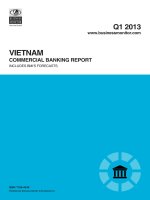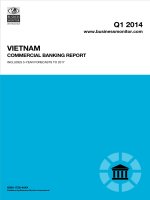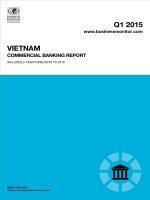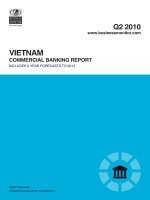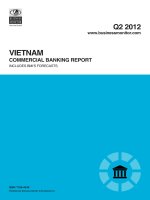Vietnam commercial banking report q3 2011
Bạn đang xem bản rút gọn của tài liệu. Xem và tải ngay bản đầy đủ của tài liệu tại đây (479.4 KB, 63 trang )
Q3 2011
www.businessmonitor.com
COMMERCIAL BANKING REPORT
ISSN 1758-454X
Published by Business Monitor International Ltd.
VIETNAM
INCLUDES BMI'S FORECASTS
Business Monitor International
Mermaid House,
2 Puddle Dock,
London, EC4V 3DS,
UK
Tel: +44 (0) 20 7248 0468
Fax: +44 (0) 20 7248 0467
Email:
Web:
© 2011 Business Monitor International.
All rights reserved.
All information contained in this publication is
copyrighted in the name of Business Monitor
International, and as such no part of this publication
may be reproduced, repackaged, redistributed, resold in
whole or in any part, or used in any form or by any
means graphic, electronic or mechanical, including
photocopying, recording, taping, or by information
storage or retrieval, or by any other means, without the
express written consent of the publisher.
DISCLAIMER
All information contained in this publication has been researched and compiled from sources believed to be accurate and reliable at the time of
publishing. However, in view of the natural scope for human and/or mechanical error, either at source or during production, Business Monitor
International accepts no liability whatsoever for any loss or damage resulting from errors, inaccuracies or omissions affecting any part of the
publication. All information is provided without warranty, and Business Monitor International makes no representation of warranty of any kind as
to the accuracy or completeness of any information hereto contained.
VIETNAM COMMERCIAL
BANKING REPORT Q3 2011
INCLUDING INDUSTRY FORECASTS TO 2015
Part of BMI’s Industry Report & Forecasts Series
Published by: Business Monitor International
Copy deadline: June 2011
Business Monitor International
Mermaid House,
2 Puddle Dock,
London, EC4V 3DS,
UK
Tel: +44 (0) 20 7248 0468
Fax: +44 (0) 20 7248 0467
Email:
Web:
© 2011 Business Monitor International.
All rights reserved.
All information contained in this publication is
copyrighted in the name of Business Monitor
International, and as such no part of this publication
may be reproduced, repackaged, redistributed, resold in
whole or in any part, or used in any form or by any
means graphic, electronic or mechanical, including
photocopying, recording, taping, or by information
storage or retrieval, or by any other means, without the
express written consent of the publisher.
DISCLAIMER
All information contained in this publication has been researched and compiled from sources believed to be accurate and reliable at the time of
publishing. However, in view of the natural scope for human and/or mechanical error, either at source or during production, Business Monitor
International accepts no liability whatsoever for any loss or damage resulting from errors, inaccuracies or omissions affecting any part of the
publication. All information is provided without warranty, and Business Monitor International makes no representation of warranty of any kind as
to the accuracy or completeness of any information hereto contained.
VIETNAM COMMERCIAL
BANKING REPORT Q3 2011
INCLUDING INDUSTRY FORECASTS TO 2015
Part of BMI’s Industry Report & Forecasts Series
Published by: Business Monitor International
Copy deadline: June 2011
Vietnam Commercial Banking Report Q3 2011
© Business Monitor International Ltd Page 2
Vietnam Commercial Banking Report Q3 2011
© Business Monitor International Ltd Page 3
CONTENTS
Executive Summary 5
Table: Levels (VNDbn) 5
Table: Levels (US$bn) 5
Table: Levels At August 2010 5
Table: Annual Growth Rate Projections 2011-2015 (%) 6
Table: Ranking Out Of 59 Countries Reviewed In 2011 6
Table: Projected Levels (VNDbn) 6
Table: Projected Levels (US$bn) 7
SWOT Analysis 8
Vietnam Commercial Banking SWOT 8
Vietnam Political SWOT 9
Vietnam Economic SWOT 10
Vietnam Business Environment SWOT 11
Business Environment Outlook 12
Commercial Banking Business Environment Rating 12
Table: Commercial Banking Business Environment Ratings 12
Commercial Banking Business Environment Rating Methodology 13
Table: Asia Commercial Banking Business Environment Ratings 14
Global Commercial Banking Outlook 15
Asia Banking Sector Outlook 19
Table: Banks’ Bond Portfolios 24
Table: Asia Commercial Banking Business Environment Ratings 25
Table: Comparison Of Loan/Deposit, Loan/Asset And Loan/GDP Ratios 26
Table: Anticipated Developments In 2011 27
Table: Comparison Of Total Assets, Client Loans And Client Deposits , 2009-2010(US$bn) 28
Table: Comparison Of Per Capita Deposits, 2010 (US$) 29
Table: Interbank Rates And Bond Yields 30
Vietnam Banking Sector Outlook 31
Economic Outlook 34
Table: Vietnam Economic Activity, 2008-2015 36
Company Profiles 37
Vietcombank 37
Table: Key Statistics For Vietcombank, 2004-2008 (VNDmn) 38
BIDV 39
Table: Key Statistics For BIDV, 2004-2006 (VNDmn) 40
VietinBank 41
Table: Key Statistics For VietinBank, 2005-2008 (VNDmn) 42
Agribank 43
Table: Balance Sheet (VNDmn, unless stated) 44
Table: Balance Sheet (US$mn, unless stated) 44
Table: Key Ratios (%) 44
MHB Bank 45
Vietnam Commercial Banking Report Q3 2011
© Business Monitor International Ltd Page 4
Table: Key Statistics For MHB Bank, 2006-2008 (VNDmn) 46
Habubank 47
Table: Key Statistics For Habubank, 2004-2007 (VNDmn) 48
Eximbank 49
Table: Balance Sheet (VNDmn, unless stated) 50
Table: Balance Sheet (US$mn, unless stated) 50
Table: Key Ratios (%) 50
Sacombank 51
Table: Stock Market Indicators 52
Table: Balance Sheet (VNDmn, unless stated) 52
Table: Balance Sheet (US$mn, unless stated) 53
Table: Key Ratios (%) 53
Saigonbank 54
Table: Stock Market Indicators 54
Table: Balance Sheet (VNDmn, unless stated) 55
Table: Balance Sheet (US$mn, unless stated) 55
Table: Key Ratios (%) 55
SeABank 56
Table: Balance Sheet (VNDmn, unless stated) 56
Table: Balance Sheet (US$mn, unless stated) 57
Table: Key Ratios (%) 57
BMI Banking Sector Methodology 58
Commercial Bank Business Environment Rating 59
Table: Commercial Banking Business Environment Indicators And Rationale 60
Table: Weighting Of Indicators 61
Vietnam Commercial Banking Report Q3 2011
© Business Monitor International Ltd Page 5
Executive Summary
Table: Levels (VNDbn)
Date
Total
assets
Client
loans
Bond
portfolio
Other
Liabilities
and capital
Capital
Client
deposits
Other
August
2009 2,065,761.6
1,706,340.0
173,358.3
186,063.3
2,065,761.6
286,547.0
1,594,992.6
184,222.0
August
2010 2,624,434.1
2,191,880.0
203,131.1
229,423.0
2,624,434.1
360,566.0
2,038,758.6
225,109.5
Change,
% 27%
28%
17%
23%
27%
26%
28%
22%
Source: BMI, Central banks, Regulators
Table: Levels (US$bn)
Date
Total
assets
Client
loans
Bond
portfolio
Other
Liabilities
and capital
Capital
Client
deposits
Other
August 2009 115.9
95.7
9.7
10.4
115.9
16.1
89.5
10.3
August 2010 134.7
112.5
10.4
11.8
134.7
18.5
104.6
11.5
Change, % 16%
17%
7%
13%
16%
15%
17%
12%
Source: BMI, Central banks, Regulators
Table: Levels At August 2010
Loan/deposit ratio Loan/asset ratio
Loan/GDP ratio
GDP Per Capita,
US$
Deposits per
capita, US$
107.51% 83.52%
118.16%
1,063
1,189
Falling Rising
Rising
Source: BMI, Central banks, Regulators
Vietnam Commercial Banking Report Q3 2011
© Business Monitor International Ltd Page 6
Table: Annual Growth Rate Projections 2011-2015 (%)
Assets
Loans
Deposits
Annual Growth Rate 20
20
15
CAGR 20
20
14
Ranking 2
3
14
Source: BMI, Central banks, Regulators
Table: Ranking Out Of 59 Countries Reviewed In 2011
Loan/deposit ratio Loan/asset ratio
Loan/GDP ratio
5 2
10
Local currency asset growth
Local currency loan growth
Local currency deposit growth
5 4
12
Source: BMI, Central banks, Regulators
Table: Projected Levels (VNDbn)
2007
2008
2009
2010
2011f
2012f
2013f
2014f
2015f
Total
assets
1,410,221.40 1,747,335.40 2,411,322.85 2,893,587.42 3,472,304.91 4,166,765.89 5,000,119.07 6,000,142.88 7,200,171.45
Client
loans
1,067,730.00 1,339,260.00 1,848,178.80 2,217,814.56 2,661,377.47 3,193,652.97 3,832,383.56 4,598,860.27 5,518,632.33
Client
deposits
1,100,392.90 1,341,142.80 1,528,902.79 1,697,082.10 1,917,702.77 2,186,181.16 2,492,246.52 2,841,161.04 3,267,335.19
f = forecast. Source: BMI, Central banks, Regulators
Vietnam Commercial Banking Report Q3 2011
© Business Monitor International Ltd Page 7
Table: Projected Levels (US$bn)
2007
2008
2009
2010
2011f
2012f
2013f
2014f
2015f
Total assets 88.05
99.94
130.56
148.40
168.15
201.78
248.76
307.70
378.96
Client loans 66.66
76.60
100.07
113.75
128.88
154.66
190.67
235.84
290.45
Client deposits 68.70
76.71
82.78
87.04
92.87
105.87
123.99
145.70
171.97
f = forecast. Source: BMI, Central banks, Regulators
Vietnam Commercial Banking Report Q3 2011
© Business Monitor International Ltd Page 8
SWOT Analysis
Vietnam Commercial Banking SWOT
Strengths
Rapid growth.
Untapped potential.
High savings rate of Vietnamese.
Increasingly open to foreign banks since WTO accession in 2007.
Role of state-owned banks steadily decreasing.
Weaknesses
Domestic banks lack capital and technology to sustain high credit growth.
The financial accounts of many banks are still opaque.
High exposure to real estate and stock market loans among smaller banks.
Opportunities
Population still under-banked.
Income levels likely to rise strongly over the medium term.
Threats
Macroeconomic instabilities threaten the credibility of the government and could
potentially turn economic policy away from further liberalisation.
Vietnam Commercial Banking Report Q3 2011
© Business Monitor International Ltd Page 9
Vietnam Political SWOT
Strengths
The Communist Party of Vietnam remains committed to market-oriented reforms
and we do not expect major shifts in policy direction over the next five years. The
one-party system is generally conducive to short-term political stability.
Relations with the US have witnessed a marked improvement, and Washington
sees Hanoi as a potential geopolitical ally in South East Asia.
Weaknesses
Corruption among government officials poses a major threat to the legitimacy of
the ruling Communist Party.
There is increasing (albeit still limited) public dissatisfaction with the leadership's
tight control over political dissent.
Opportunities
The government recognises the threat that corruption poses to its legitimacy, and
has acted to clamp down on graft among party officials.
Vietnam has allowed legislators to become more vocal in criticising government
policies. This is opening up opportunities for more checks and balances within the
one-party system.
Threats
Macroeconomic instabilities in 2010 and 2011 are likely to weigh on public
acceptance of the one-party system, and street demonstrations to protest
economic conditions could develop into a full-on challenge of undemocractic rule.
Although strong domestic control will ensure little change to Vietnam's political
scene in the next few years, over the longer term, the one-party-state will probably
be unsustainable.
Relations with China have deteriorated over recent years due to Beijing's more
assertive stance over disputed islands in the South China Sea and domestic
criticism of a large Chinese investment into a bauxite mining project in the central
highlands, which could potentially cause significant environmental damage.
Vietnam Commercial Banking Report Q3 2011
© Business Monitor International Ltd Page 10
Vietnam Economic SWOT
Strengths
Vietnam has been one of the fastest-growing economies in Asia in recent years,
with GDP growth averaging 7.2% annually between 2000 and 2010.
The economic boom has lifted many Vietnamese out of poverty, with the official
poverty rate in the country falling from 58% in 1993 to 20% in 2004.
Weaknesses
Vietnam still suffers from substantial trade, current account and fiscal deficits,
leaving the economy vulnerable to global economic uncertainties in 2011. The
fiscal deficit is dominated by substantial spending on social subsidies that could be
difficult to withdraw.
The heavily-managed and weak dong currency reduces incentives to improve
quality of exports, and also serves to keep import costs high, thus contributing to
inflationary pressures
Opportunities
WTO membership has given Vietnam access to both foreign markets and capital,
while making Vietnamese enterprises stronger through increased competition.
The government will in spite of the current macroeconomic woes, continue to
move forward with market reforms, including privatisation of state-owned
enterprises, and liberalising the banking sector.
Urbanisation will continue to be a long-term growth driver. The UN forecasts the
urban population to rise from 29% of the population to more than 50% by the early
2040s.
Threats
Inflation and deficit concerns have caused some investors to re-assess their
hitherto upbeat view of Vietnam. If the government focuses too much on
stimulating growth and fails to root out inflationary pressure, it risks prolonging
macroeconomic instability, which could lead to a potential crisis.
Prolonged macroeconomic instability could prompt the authorities to put reforms
on hold, as they struggle to stabilise the economy.
Vietnam Commercial Banking Report Q3 2011
© Business Monitor International Ltd Page 11
Vietnam Business Environment SWOT
Strengths
Vietnam has a large, skilled and low-cost workforce that has made the country
attractive to foreign investors.
Vietnam's location - its proximity to China and South East Asia, and its good sea
links - makes it a good base for foreign companies to export to the rest of Asia,
and beyond.
Weaknesses
Vietnam's infrastructure is still weak. Roads, railways and ports are inadequate to
cope with the country's economic growth and links with the outside world.
Vietnam remains one of the world's most corrupt countries. Its score in
Transparency International's 2010 Corruption Perceptions Index was 2.7, placing it
in 22nd place in the Asia-Pacific region.
Opportunities
Vietnam is increasingly attracting investment from key Asian economies, such as
Japan, South Korea and Taiwan. This offers the possibility of the transfer of high-
tech skills and knowhow.
Vietnam is pressing ahead with the privatisation of state-owned enterprises and
the liberalisation of the banking sector. This should offer foreign investors new
entry points.
Threats
Ongoing trade disputes with the US, and the general threat of American
protectionism, which will remain a concern.
Labour unrest remains a lingering threat. A failure by the authorities to boost skills
levels could leave Vietnam a second-rate economy for an indefinite period.
Vietnam Commercial Banking Report Q3 2011
© Business Monitor International Ltd Page 12
Business Environment Outlook
Commercial Banking Business Environment Rating
Table: Commercial Banking Business Environment Ratings
Limits of potential returns Data
Score; out of 10
Ratings score; out of 100
Total assets; end 2010 US$148.4mn
6
Market Structure 67
Growth in total assets; 2011-2015
7
Growth in client loans; 2011-2015
7
Per-capita GDP; 2011 US$1,265.3
2
Country Structure 53
Tax 2.9
3
GDP volatility 0.4
10
Financial infrastructure 5.6
6
Risks to realisation of returns
Regulatory framework and
development
4.5
5
Market Risk 40
Regulatory framework and
competitive landscape
5.0
5
Moody's rating for local currency
deposits 2.0
2
Long-term financial risk 4.8
5
Country Risk 46
Long-term external risk 3.3
3
Long-term policy continuity 7.0
7
Legal framework 3.7
4
Bureaucracy 3.9
4
Commercial banking business environment rating
56
Source: BMI
Vietnam Commercial Banking Report Q3 2011
© Business Monitor International Ltd Page 13
Commercial Banking Business Environment Rating Methodology
Since Q108, we have described numerically the banking business environment for each of the countries
surveyed by BMI. We do this through our Commercial Banking Business Environment Rating (CBBER),
a measure that ensures we capture the latest quantitative information available. It also ensures consistency
across all countries and between the inputs to the CBBER and the Insurance Business Environment
Rating, which is likewise now a feature of our insurance reports. Like the Business Environment Ratings
calculated by BMI for all the other industries on which it reports, the CBBER takes into account the
limits of potential returns and the risks to the realisation of those returns. It is weighted 70% to the former
and 30% to the latter.
The evaluation of the 'Limits of potential returns' includes market elements that are specific to the
banking industry of the country in question and elements that relate to that country in general. Within the
70% of the CBBER that takes into account the 'Limits of potential returns', the market elements have a
60% weighting and the country elements have a 40% weighting. The evaluation of the 'Risks to
realisation of returns' also includes banking elements and country elements (specifically, BMI's
assessment of long-term country risk). However, within the 30% of the CBBER that takes into account
the risks, these elements are weighted 40% and 60% respectively.
Further details on how we calculate the CBBER are provided at the end of this report. In general, though,
three aspects need to be borne in mind in interpreting the CBBERs. The first is that the market elements
of the 'Limits of potential returns' are by far the most heavily weighted of the four elements. They account
for 60% of 70% (or 42%) of the overall CBBER. Second, if the market elements are significantly higher
than the country elements of the 'Limits of potential returns', it usually implies that the banking sector is
(very) large and/or developed relative to the general wealth, stability and financial infrastructure in the
country. Conversely, if the market elements are significantly lower than the country elements, it usually
means that the banking sector is small and/or underdeveloped relative to the general wealth, stability and
financial infrastructure in the country. Third, within the 'Risks to the realisation of returns' category, the
market elements (ie: how regulations affect the development of the sector, how regulations affect
competition within it, and Moody's Investor Services' ratings for local currency deposits) can be
markedly different from BMI's long-term risk rating.
Vietnam Commercial Banking Report Q3 2011
© Business Monitor International Ltd Page 14
Table: Asia Commercial Banking Business Environment Ratings
Limits of Potential
Returns
Risks to Potential
Returns Overall
Market
Structure
Country
Structure
Market
Risks
Country
Risks
Rating
Ranking
Bangladesh 43.3
45.0
30.0
44.0
42.3
56
China 93.3
55.0
56.7
76.0
75.1
12
Hong Kong 73.3
92.5
70.0
84.0
80.2
9
India 83.3
55.0
53.3
56.0
66.9
23
Indonesia 73.3
62.5
76.7
42.0
65.1
28
Japan 33.3
77.5
63.3
80.0
57.7
38
Malaysia 70.0
80.0
76.7
78.0
75.0
13
Pakistan 40.0
50.0
56.7
36.0
44.1
54
Philippines 50.0
62.5
56.7
52.0
54.7
43
Singapore 70.0
95.0
96.7
86.0
83.1
6
Sri Lanka 23.3
55.0
36.7
46.0
37.9
57
South Korea 80.0
85.0
76.7
70.0
79.2
10
Taiwan 76.7
72.5
83.3
74.0
75.8
11
Thailand 56.7
65.0
80.0
68.0
63.8
31
Vietnam 66.7
52.5
40.0
46.0
55.8
40
US 90.0
85.0
100.0
76.0
87.3
2
Scores out of 100, with 100 the highest. Source: BMI
Vietnam Commercial Banking Report Q3 2011
© Business Monitor International Ltd Page 15
Global Commercial Banking Outlook
Outlook Continues To Improve With Risks
In line with generally improving world macroeconomic conditions, the outlook for the global banking
sector continues to solidify. Although we are mindful of risks from rising oil prices and inflation, unrest
in the Middle East and North Africa (MENA) and reverberations from the global supply chain emanating
from Japan’s earthquake and tsunami, our global outlook remains generally upbeat. This backdrop should
provide a sufficient foundation for continued loan and asset growth. This is particularly the case for
emerging markets and developed states that did not experience banking sector crises in 2007-2009. Major
potential headwinds include global monetary tightening, which will be concentrated in emerging markets.
Lending Growth Depends On Macro
US – Real GDP Growth And Bank Lending
Source: BMI, Federal Reserve
US and eurozone: The US macro outlook suggests mixed prospects for its commercial banks. Bank
lending tends to expand alongside economic growth and in this respect, with decent but not particularly
strong economic expansion forecast for the foreseeable future, banking sector loan growth will be slow
for some time. Importantly, we continue to believe that in the current climate of household deleveraging,
there will be subdued demand for credit. 2011 and 2012 are set to be slow growth years for the
eurozone’s banking sector as the effects of fiscal austerity are felt across the currency bloc and banks
remain hesitant to significantly ramp up lending towards the levels experienced prior to the global
financial crisis, particularly amid tighter capital constraints. That said, despite monetary tightening,
confidence in the eurozone banking sector has continued to hold up well. This supports our view that the
Vietnam Commercial Banking Report Q3 2011
© Business Monitor International Ltd Page 16
risks from monetary tightening to consumer demand and banking sector stability in the eurozone have
been overplayed.
Emerging Asia: The Emerging Asia banking outlook is generally positive, though we have some
concerns about some of the highest flying sectors. In particular, we are concerned that loan loss
provisions in the Chinese banking system are hugely underestimated and that the stability of the industry
rests on non-performing loans remaining well behaved, which has historically not been the case following
policy-driven lending sprees. Despite the potential for economic damage following the March 2011
earthquake and tsunami to have a negative impact on Japanese banks’ assets in the short term, we are
bullish about Japanese banking sector equities. However, we note that this is due to our expectation of
multiple expansion rather than improvements to banks’ balance sheets, which we expect to be negatively
affected by rising bond yields.
End To Deflation In Sight
Japan – Client Loans, % change y-o-y
Source: Bank of Japan, BMI
Emerging Europe: While Western Europe is struggling to contain a regional sovereign debt crisis and
revive economic growth, the same pressures are less severe in emerging Europe. With the exception of
idiosyncratic cases, banking sectors across emerging Europe are broadly on the road to recovery and due
to expand at a faster rate in 2011 than in 2010. Efforts to raise capital ratios, as well as less severe
sovereign debt stresses than in the eurozone and the UK, will buoy sentiment and growth over the
medium term.
Vietnam Commercial Banking Report Q3 2011
© Business Monitor International Ltd Page 17
On The Mend
Emerging Europe – Bank Sector Assets, % change y-o-y
Source: BMI, central banks
Latin America: We expect massive expansion of the financial services sector in Latin America over the
next few years, driven by an expanding middle class, financial market integration and the ongoing search
for yield among developed market investors. This is not a new theme for the region, but it is one we
believe will continue to offer opportunities for high-end financial services expansion over the next few
years. As the Latin American population becomes richer, demand for companies that are able to manage
this wealth will continue to increase and big financial names are set to keep expanding their footprints in
the region.
Sub-Saharan Africa: The region’s major banking sectors (South Africa, Nigeria and Kenya) are all
continuing their recoveries, albeit with varying degrees of strength. Forecast strong economic growth will
boost incomes, which will in turn enable an increase in deposits and greater take-up of banking services.
Rebounding economic activity and improved liquidity are bolstering banking sector growth.
Vietnam Commercial Banking Report Q3 2011
© Business Monitor International Ltd Page 18
Liquidity Improving
MENA – Banking Sector Deposit Growth, % change y-o-y
Source: BMI, central banks
Middle East and North Africa: The outlook for banks across the MENA region is by no means uniform.
We expect banks in Qatar and the UAE to outperform through the rest of 2011 as higher oil prices and
improved sentiment enable Doha and Dubai to solidify their reputations as stable hubs for the regional
financial services industry. In contrast, the outlooks for Bahrain and Egypt’s banking sectors remain
particularly weak and a marked decrease in asset quality should be expected as a result of widespread
social unrest and disruptions to local economic activity.
Vietnam Commercial Banking Report Q3 2011
© Business Monitor International Ltd Page 19
Asia Banking Sector Outlook
Islamic Finance In Asia: Permeating Across Borders
Islamic banking and shari’a-compliant financing activities will expand significantly over the medium
term, with countries such as Malaysia and Indonesia becoming increasingly competitive. While there will
still be resistance to Islamic finance, especially in South Korea, due to local religious sensitivities, we
generally expect the industry to penetrate deeper into the region, including in non-Muslim majority
countries, due to rising profitable opportunities within the Islamic world.
We believe the Islamic banking industry in Asia will continue to achieve impressive growth over the
medium term, with predominately Muslim countries such as Malaysia and Indonesia spearheading this
expansion. We also expect non-Muslim majority economies, including Singapore, Hong Kong, and even
Australia, to experience a rise in Islamic financing activities following encouragement by their respective
authorities. The key exception, however, will be the South Korea, due to potential political opposition
from some Christian quarters in the country.
Malaysia: Leader Of The Pack
In terms of value of total global sukuk (Islamic bonds) and number of issuances, Malaysia stands out as a
global leader, outpacing even its Middle Eastern counterparts. The country has been responsible
for US$94bn worth of total sukuk issuances, comprising 66% of total outstanding global sukuk. Key
Malaysian underwriters such as CIMB and Malayan Banking (Maybank) regularly dominate
Bloomberg’s Islamic finance league tables, outpacing other firms such as Dubai Islamic Bank (DIB).
CIMB currently clinches the top spot (as of April 19 2011), having underwritten US$1.1bn worth of new
Islamic issuances, while Maybank issued US$518.3mn. DIB, on the other hand, underwrote
US$277.9mn. Other key Malaysian underwriters include RHB and AmInvestment Bank, which are
among the top 10 Islamic underwriters.
Vietnam Commercial Banking Report Q3 2011
© Business Monitor International Ltd Page 20
Malaysian Underwriters Dominate
Global – Top 10 Islamic Underwriters Jan-April 2011 By Total Deals, US$mn
Source: Bloomberg
In early 2011, the Malaysian government unveiled the Shari’a Governance Framework, which is designed
to reduce legal uncertainty in shari’a-compliant financing activities. The 2009 Central Banking Act also
says the Shari’a Advisory Council - the highest Islamic finance authority in Malaysia - will have the final
say in the event of any disputes, helping to provide a sound legal framework in Malaysia. The high court
has appointed a judge who specialises in Islamic finance-related litigation, providing Malaysia with an
attractive legal environment for Islamic banks.
Vietnam Commercial Banking Report Q3 2011
© Business Monitor International Ltd Page 21
Roaring Ahead
Malaysia – Islamic Financing, MYRmn and % of total loans
Source: Bank Negara Malaysia, BMI
Malaysia’s progress in Islamic finance puts it in pole position to be a global leader in influencing industry
development of shari’a-compliant banking in other aspiring countries. We believe the Islamic Financial
Services Board, an international advisory group based in Kuala Lumpur, will have an increasingly
important role going forward. While this should ultimately result in greater competition between
countries, Malaysia’s first-mover advantage and supportive infrastructure should help it evolve into an
important regional, or even global, Islamic financial hub.
Budding Opportunities In Indonesia
While they are not as well developed as Malaysia in terms of scale and international reach, we believe the
Islamic banking industries in Indonesia, Pakistan and Bangladesh will still experience firm domestic
expansion over the coming years, catering for rising demand from Muslim populations. This should
provide interesting expansion opportunities for local banks and foreign players that are interested in
setting up in these countries.
Vietnam Commercial Banking Report Q3 2011
© Business Monitor International Ltd Page 22
Follow The Leader
Asia – Islamic Financial Assets, US$bn and % of banking sector
* = estimate. Source: Central banks, BMI
In Indonesia, shari’a-compliant banks and banking units recorded total assets worth US$11.0bn,
accounting for 3.2% of the country’s total banking assets. In view of the country’s strong economic
growth potential and large Muslim population (the largest in the world), we expect Islamic finance to
increase in importance within the region. In particular, Malaysia’s close proximity to Indonesia should
put Malaysian banks in the best position to take advantage of this favourable trend.
Bursa Malaysia-listed Affin Holdings is in the process of acquiring Indonesia’s Bank Ina Perdana.
Interestingly, the bank is not a shari’a-compliant bank and all of its 25 branches will need to undergo a
conversion process that may take about two years. Bank Internasional Indonesia and Bank Maybank
Syariah Indonesia (a Maybank subsidiary) are in merger talks at the time of writing, indicating that the
Islamic banking sector in the country is gaining favour.
Bangladesh And Pakistan: Key Frontiers
Bangladesh and Pakistan’s Islamic financial companies are considerably smaller than their South East
Asian counterparts in terms of total assets and market capitalisation. That said, we emphasise that they
still play a considerably important role in their domestic banking sectors. We estimate that shari’a-
compliant banking assets make up about 4% of the Pakistan’s financial assets. In Bangladesh, a Daily
Star report suggested that Islamic deposits account for more than 16% of the total in the banking sector.
Vietnam Commercial Banking Report Q3 2011
© Business Monitor International Ltd Page 23
The development of Islamic microfinance is a potential growth area in these lower-income economies
over the coming decade. The majority of microlending remains conventional, as the prohibition of usury
(riba), or late payment fees, has made the structuring of such high-risk loans difficult in Islamic finance.
In view of these challenges, further financial innovation in Islamic instruments, such as murabaha (cost-
plus pricing that is suitable for small traders), may be required in order for Islamic microfinance to
flourish.
Rising Interest Elsewhere
Outside the Islamic world, there is increasing interest in Islamic finance from non-Muslim majority
countries such as Thailand, Singapore, Hong Kong and even Australia. In the aftermath of the global
financial crisis, many investors regard shari’a-based lending and investment, which prohibits excessive
risk (gharir), as a safer, more reliable way of fund management (although this may be more of a
perception than an established fact). A well developed Islamic financial infrastructure will place these
countries in good stead to receive and manage fund inflows from the Middle East, benefiting from the rise
in oil prices. A key exception to this trend, however, is South Korea, where there has been vehement
opposition from the Christian lobby in the country. A proposed law to allow the issuance of sukuk failed
to pass in 2011, indicating that the appeal of shari’a-based financing is not universal.


